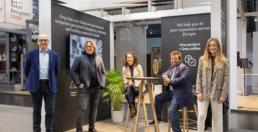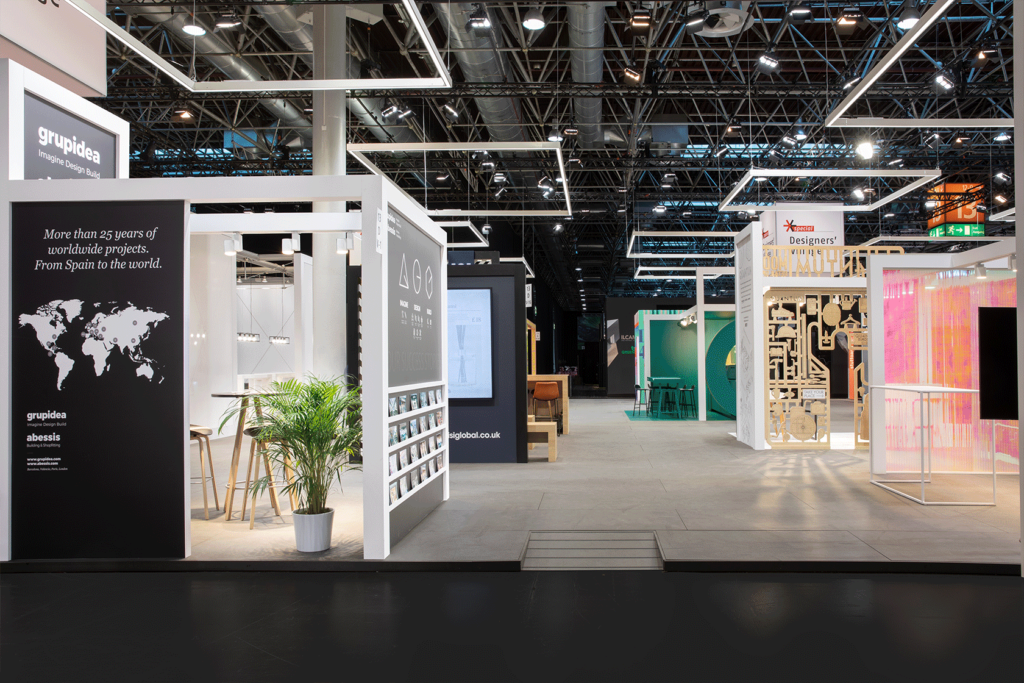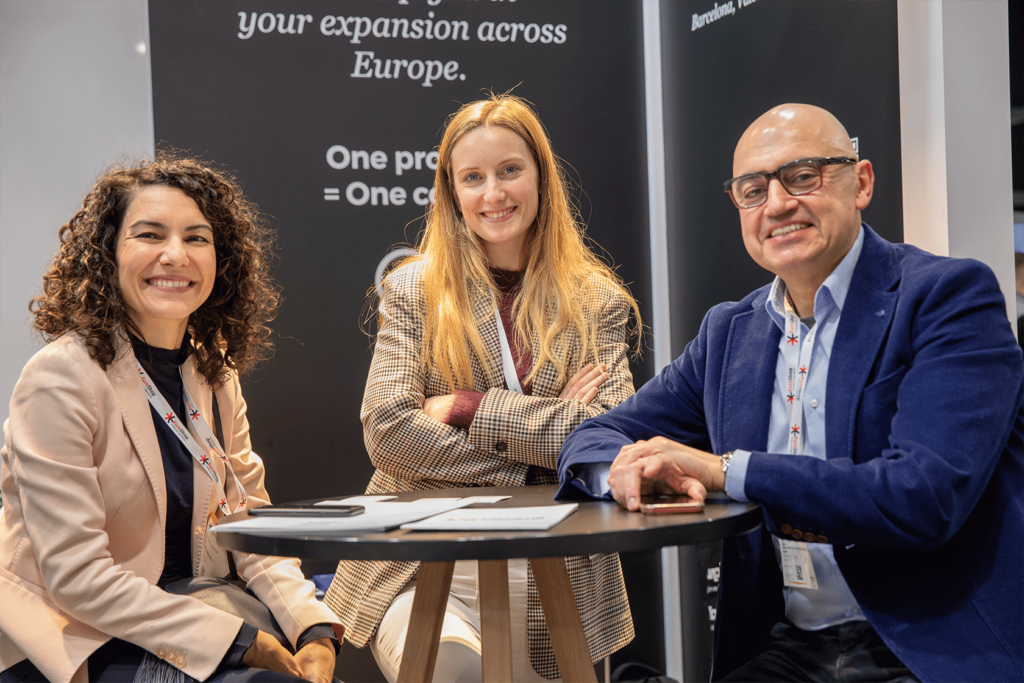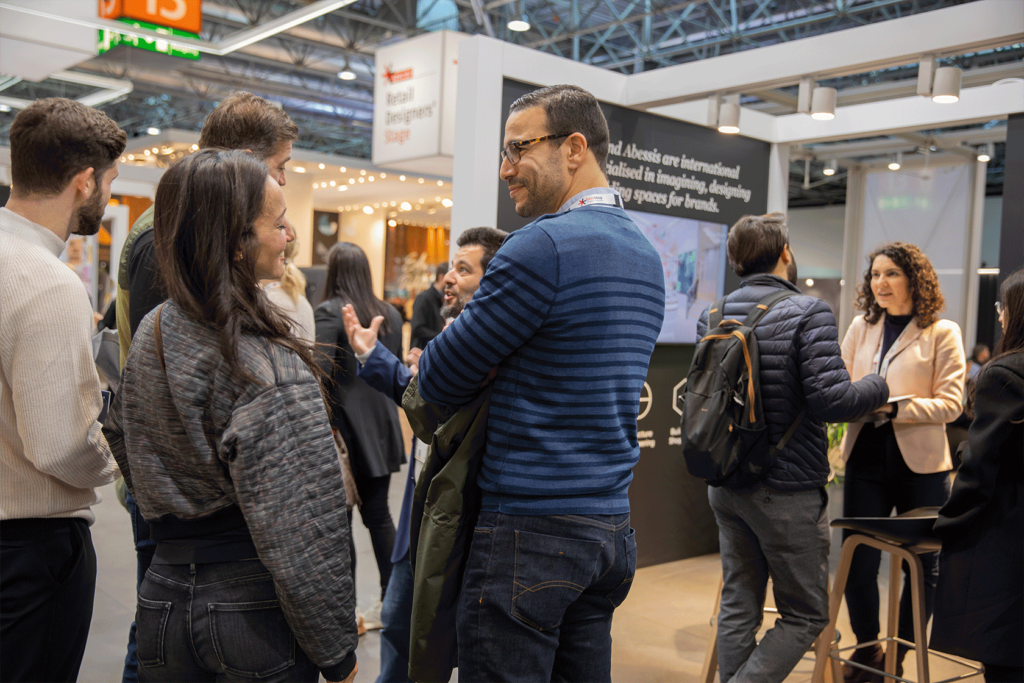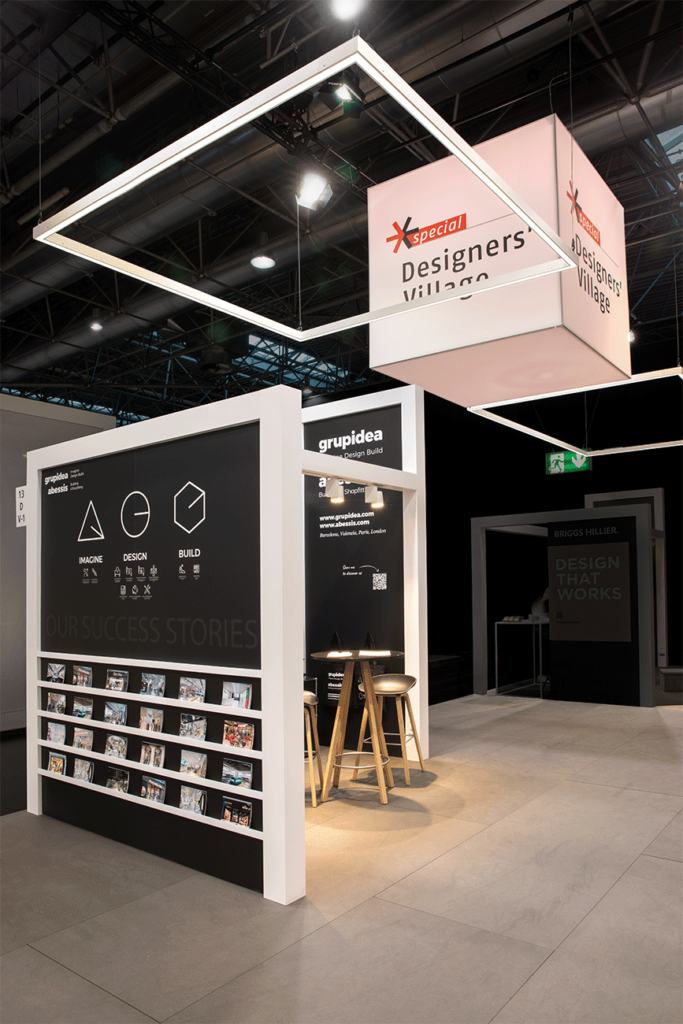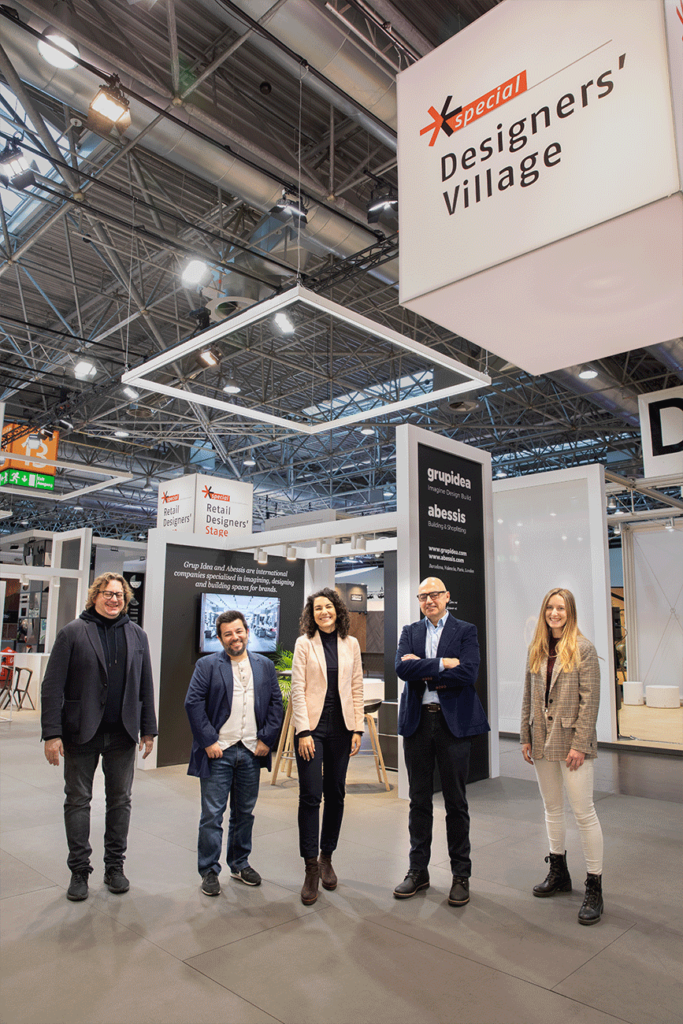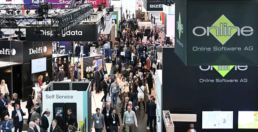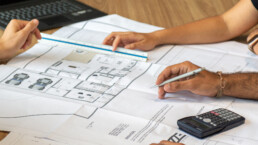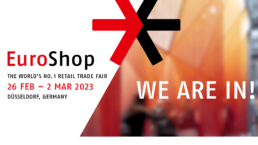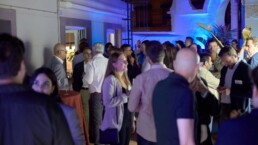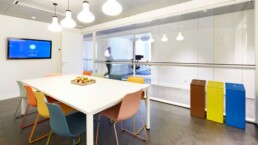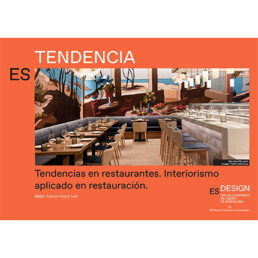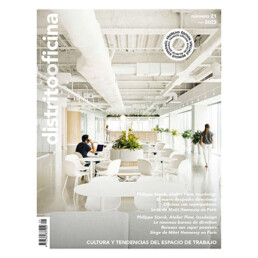Warm welcome to Grup Idea & Abessis at the leading retail trade fair EuroShop
The 21st edition of EuroShop 2023, the leading retail trade fair, came to an end on 2 March with a successful turnout of more than 81,000 visitors and 1,830 exhibitors from 55 countries. On this occasion, Grup Idea & Abessis were there for the first time as exhibitors with our own stand to present our work method, services and international retail projects and works all over Europe.
Located in the Designers' Village, the area reserved for architecture and design studios, we shared space with nine other young agencies already established in design and shopfitting, mainly from the United Kingdom and Germany. From the designers' area, only Grup Idea & Abessis came from Spain. For five days we welcomed professionals from the retail sector to our stand: technicians, suppliers, collaborators and clients in a very positive atmosphere of professional exchange and business opportunities.
During the fair, we had the opportunity to talk to the entire ecosystem of manufacturing companies, especially in the field of lighting, new materials, finishes and their high quality solutions to improve design and equipment in the retail sector. We also attended various talks at the Store Design Stage and Retail Designer's Stage to learn first-hand about the latest trends in design for an optimal customer journey and the implications of sustainability and digitalisation in the design and construction of points of sale. Sustainability and digitalisation were the most common cross-cutting themes in the retail products exhibited and offered at the fair, from shopping stands, mannequins and decorative busts to lighting and refrigeration equipment.
For the event organisers themselves, the new edition of EuroShop has had a very positive impact, especially after three years of uncertainty and in view of the current challenges in the sector. "We would like to thank our exhibitors. With their innovative strength they have once again proved to be a magnet for the entire industry," said Erhard Wienkamp, managing director of the trade fair, in a press release. The next EuroShop at Messe Düsseldorf will be held from 22 to 26 February 2026.
Marketing Directo - EuroShop 2023: this was the 21st edition of the retail trade fair
Grup Idea and Abessis are two of the Spanish-based companies that participated as exhibitors at the EuroShop 2023 retail fair. The report entitled 'More than 80,000 visitors attend EuroShop 2023, which makes clear its leadership in the retail sector', published in the digital media Marketing Directo, summarises the past edition and includes the testimony of several exhibiting companies, including Grup Idea and Abessis. With the participation of Lluis Sáiz.
EuroShop 2023, the world's most important retail trade fair, has successfully concluded its 21st edition. After five days, the curtain came down on the congress held at the Düsseldorf exhibition centre on Thursday, 2 March, which attracted 81,000 visitors from all five continents, with a large number of international visitors: 68% of the EuroShop audience came from outside Germany.
Particularly positive was the increase in visitors from Southeast Asia, Africa and North America. In total, EuroShop 2023 trade visitors from 141 countries came to EuroShop, including countries as far afield as Brazil, Australia and New Zealand.
The number of exhibitors, 1,830 exhibitors from 55 nations, has increased this year compared to previous editions. Erhard Wienkamp, CEO of Messe Düsseldorf, was very satisfied with the results of the event and said: "In view of the current challenges facing the retail trade, we are delighted that EuroShop has once again fulfilled its role as the world's leading trade fair offering orientation and guidance. "We owe our exhibitors a great compliment. With their innovative strength they have once again proved to be a magnet for the entire industry," he added.
Read the original article in full by clicking on the link to the Marketing Directo report to read the full article in Spanish.
The stages in a retail architecture and construction project
We discover the step by step of an integral "turnkey" project and all its advantages.
When considering the opening or refurbishment of a store or planning the expansion of our brand, uncertainty may arise as to the steps to follow in the design, implementation and construction of our space. Choosing a good location, choosing one premises or another depending on its technical characteristics or meeting the delivery date of the work can often become a big headache. The sum of our services of architecture and engineering, construction and shopfitting allow us to provide a complete solution to the needs of our clients. Our method is reduced to 6 steps, six phases that help us to achieve efficiency and effectiveness in Design and Built.
1. Drafting of the feasibility study
The first step of the project is the drafting of the feasibility study of the premises. We collect images of the space, carry out a study of the location and its characteristics to determine the suitability of the premises. The feasibility study is a detailed study to assess whether the premises meet the minimum technical conditions necessary to carry out the activity, whether it is a retail space, offices for the brand or any other type of activity.
To do this, our technicians will check the measurements of the premises, possible structural pathologies or any other type of pathology, the time period foreseen for the granting of building and/or activity licences, the connections of the installations, accessibility, ventilation and lighting, or fire safety, among other aspects.
It is essential to check these aspects before renting or buying premises, as this study can be used to negotiate aspects such as grace periods or to obtain a better price for the purchase or rental of the premises. These aspects largely condition the success of the business you want to open. Therefore, gathering all this information is essential.
2. Layout definition and approval by the client
Once the choice of premises seems ideal, before proceeding with the decision making process, a preliminary study of the interior space is carried out. Based on the necessary functional programme provided by the property, first the spaces and routes of both the areas open to the public and the internal areas such as services, archives and other more private uses, but necessary to carry out the activity, are schematized and zoned. The accesses and evacuation routes are also analysed and reflected. Because it is not only a question of seeing if the uses fit into the space in terms of surface area, but also of analysing whether the premises will allow the logic of the routes necessary for the user experience in the space required by the brand.
From there, in this study, one or several distribution proposals are included in which the future technical development and the zoning of the space for the use of the premises is schematically drawn. This is what we call the Layout. In this Layout, the distribution of the elements and spaces within the design to be developed in the following phases of the project will be plotted. If this work is not carried out, it is possible that although the premises may seem ideal in terms of surface area, free heights, unevenness and other technical characteristics of the space, it may not be so, as it will not allow us to implement the specific Customer Journey that the project requires.
Once the layout has been completed, an initial cost estimate is made with Abessis.
3. Obtaining all necessary permits
The next step is to obtain the necessary permits for the work and those licences required depending on the country. In Spain, for example, even within the same city, the procedure with the administration can vary and previous experience in other projects is very important. It is important to know which procedures are necessary depending on the characteristics of the premises.
Your choice depends on obtaining the building and activity permits in a quick and agile manner.
At Grup Idea we have carried out projects, managed and built works in the main cities throughout the peninsula and the Canary and Balearic Islands. Likewise, in Europe we have extensive experience in architecture and engineering services as well as in construction. We incorporate local technicians with extensive experience in each country into the project to avoid surprises and to know, from the outset, what the deadlines are for obtaining permits and complying with the regulations in each country, both for installations and civil works. Find out about our complete architecture and engineering (implementation) service.
4. Preparation of the Construction Pack: Architectural and MEP executive project
When the time comes, we move forward with the technical development of the project: the architectural executive project and the engineering project or MEP, also known as the Construction Pack.
With the architectural project we draw up the plans, elevations and sections of the final proposal and through the engineering project or MEP, the calculation and realisation of the installation, air conditioning, electrical and plumbing plans. In parallel to the executive projects, the choice of furniture and the application of technology and branding in the space are approved with the client.
5. Allocation of the work and turnkey projects
Once the Construction Pack has been prepared, and with the actual project defined and delimited, it is ready to go out to tender and assign the work.
At Grup Idea and Abessis, we offer turnkey projects to our clients. With this method, the client has the peace of mind of having a single interlocutor, the Project Manager, who is in charge of the complete management of the project and the work. At a time of heavy workload, it is optimal to have a single person in charge of the project who can inform the client at all times and resolve any unforeseen events quickly and effectively.
On the other hand, with this formula we involve the construction company in the design process, providing solutions that, from the specialists' point of view, can help to optimise the final budget. Find out more about our turnkey service.
6. Execution of the work, legalisation of the installations and AS Built
In this last step, Grup Idea and Abessis carry out the management and execution of the work and all the industrialists involved. We are in charge of everything from the demolition phase, masonry, finishes, electrical installations, air conditioning, plumbing and fire protection, manufacture and installation of furniture, right through to the final fitting out of the premises on the day of the inauguration.
After completion of the works, we carry out the legalisation of the installations: electricity, plumbing and drainage, air conditioning and fire protection. Finally, we generate the As Built dossier, which consists of drawing up the modified end-of-works plans and delivering all the documentation to the company.
At Abessis we have our own working method based on good planning, a direct and close relationship and transparent management and execution. In addition, we have the quality certifications and sufficient technology so that our clients can monitor the work remotely and through any device. Discover the step-by-step of our methodology graphically here.
It may seem like a long road full of obstacles, but at Grup Idea and Abessis we optimise all our efforts by working with clients and technicians as a single team. In addition, we guarantee a surprising and profitable result, our 25 years of experience all over the world endorse us. Discover now all our projects and works in the retail sector.
Grup Idea & Abessis at Euroshop 2023
From 26th February to 2nd March we will be at Euroshop 2023, the world's most important international retail fair held in Düsseldorf, Germany. This year, Grup Idea and Abessis will have our own stand, stand DV-1 in Hall 13 located in the Designers' Village, the space reserved for architects' offices and design studios.
From our stand at EuroShop Designers' Village, we will present examples of our work and all our services for the retail sector. We will be there to give visibility to our company and welcome all visitors who come to meet us, we will be happy to meet you personally! Book now your thirty-minute meeting with our Head of Business Development & Communications via this link.
The Euroshop retail fair takes place every three years and brings retailers together with suppliers and potential customers who can help expand their business and increase their position and authority. In addition, the fair showcases a wide range of products and services that set trends in global trade. See the full programme on the fair's website. See you at Euroshop 2023!
Idea PikaPika XVII SPECIAL "RETAIL future afterwork '22 in Valencia" by Grup Idea and Abessis.
Grup Idea and Abessis have once again attended the digitalisation and trends forum for commerce RETAIL future organised by Oficina PATECO de la Comunitat Valenciana on 27th, 28th and 29th October. In its 5th edition, and with a 100% face-to-face programme, Grup Idea and Abessis participated as collaborators in the RETAIL future forum. In addition, this year Grup Idea and Abessis have gone a step further with the organisation of the RETAIL Future Afterwork '22 event in collaboration with RETAIL future.
Within the framework of the forum, and with the help of Miquel Àngel Julià Hierro, Director of Strategy and Design at Grup Idea, we participated in the round table on design, retail and customer experience. In this round table debate, different specialists talk about interior design, commercial architecture and the adaptation of physical and digital commercial space and how to overcome the challenge of bringing design to small businesses as a tool for improvement. They also discuss technology applied to the design of physical space, interior design, commercial architecture and visual merchandising in the face of an increasingly "digital" experience, in which the differences between physical and digital space are blurred to offer an integrated experience to the customer. Discover now the panel discussion Design and retail: from guerrilla design to the "figital" experience[in spanish].
RETAIL future afterwork '22: the networking event on phygital retail, design, construction and technology
This year, after the first day of the forum, Grup Idea and Abessis in collaboration with RETAIL future, the economic observatory EIXOS and KEANU organised the RETAIL future afterwork '22. The event was held on Thursday 27 October at 20.00h at the offices of Grup Idea and Abessis in Valencia and was part of the programme of the 5th edition of RETAIL future, the forum on trends and digitalisation for small businesses and crafts.
What is the metaverse and how can I adopt it to make an impact and build customer loyalty? How can big data help me in the success of my business?
During the networking event, these and other questions about the importance of the shopping experience and retail trends in design and construction were answered. Through EIXOS, we discovered how information from big data can help our business in making strategic decisions, such as deciding the optimal location of a commercial premises. We also had the magic of KEANU, a studio specialised in creating immersive experiences with the workshop "Journey to the Metaverse". Discover now the video summary of the event [in spanish]:
About the organisation of RETAIL future afterwork '22
Coinciding with the World Design Capital, Grup Idea and Abessis have promoted the RETAIL future afterwork '22, an event held in collaboration with RETAIL future and part of the programme of the 5th edition of RETAIL future. The event also counts with the collaboration of EIXOS and KEANU.
Grup Idea is a company specialised in imagining, designing and building commercial spaces, offices, restaurants and healthcare centres worldwide. Together with Abessis, a construction and construction management company based in Valencia, they are able to offer the 360º project, the turnkey project, from the design and previous strategy to the construction and final delivery.
RETAIL future is the forum that promotes reflection and debate and advances trends for both small businesses and crafts. This year it celebrates its fifth edition and has established itself as an annual event organised by the PATECO Office - Commerce and Territory of the Council of Official Chambers of Commerce, Industry, Services and Navigation of the Valencian Community and is part of the Plan to Promote the digital transformation of commerce and crafts of the Valencian Community 2021-2023.
The EIXOS economic observatory combines data from fieldwork with open data from public administrations with the aim of offering reports with reliable indicators to entrepreneurs, franchisers or chains of establishments.
KEANU is a studio made up of creatives, techies, branding experts and designers specialised in creating technological and immersive experiences for brands and agencies.
Bank offices design, what factors should be considered?
Within the design of offices and corporate headquarters for major brands, the design and construction of offices and bank branches has been Grup Idea's speciality and original activity since its beginnings more than 25 years ago.
Whether the adaptation is based on the guidelines provided by the bank's internal team or the design and construction project needs to be carried out from scratch, we have a tailor-made solution for each client.
In addition to strictly complying with the specific security regulations for the sector, it is very important to build and enhance a brand image with a retail strategy tailored to the existing needs. What aspects should be taken into account in the design of bank branches? We show you.
The importance of brand identity
More and more, banking institutions are looking for a renewed image: modern, open and welcoming without renouncing the essence and the desire to be at the customer's side. Design is the tool that allows bank branches to differentiate themselves today.
As we saw in the interview with our experts in design and project management, office spaces and bank headquarters must reflect the dynamism and variability that has become part of our rhythm of life. The trend in the design of spaces is to place the customer at the centre, to create comfortable spaces in which to offer efficient and quality service as well as spaces for relaxation and conversation.
On the other hand, the customer experience also involves offering spaces as meeting places with the brand. In this sense, the application of corporate image is very important. Thus, the drafting of a White Book with the constructive details to be applied in each case is a very useful tool, in the same way as the Style Manual that Branding agencies use for the application of the brand.
On the other hand, in our projects we take into account the importance of preserving the pre-existing elements in the spaces, some of which have heritage or differential value that help to build the brand identity.
Technology and phygital experience in banking
Technology is the great ally in delivering a superior customer experience, reducing operational costs, gaining efficiency and improving sales force productivity. While improving remote service delivery and evolving the physical branch in parallel, the challenge is to offer a hybrid experience to customers.
In design, and more specifically in the retail sector, the phygital experience seeks precisely to unite the physical and digital worlds and generate complete and satisfactory experiences with the focus always on the user. In banking, an example is the request for an appointment via mobile phone to make a transaction at the branch. So can the digital service at the branch entrance, where a member of staff is automatically alerted so that he or she can access all customer data related to the bank and interact quickly with the customer if there is a problem.
The biggest challenge is to incorporate this phygital experience to the point of achieving a fully omnichannel experience, with the same level of quality, image and service regardless of the channel of contact with the customer. As the Retail Banking Top trends 2021 study shows, companies that learn to include the human touch in their digital interactions will be better equipped to build trust and emotional connections with customers.
Individualised service, trust and loyalty
At a time of transformation of the bank branch, the physical branch has a key role to play in enhancing the human relationship and maintaining customer trust and loyalty. In terms of design, it is important to have private areas and individualised service rooms.
In our latest bank branch projects, priority has been given to customer service areas designed for personalised treatment. There, customers can receive individualised guidance and advice on how to manage their finances and information on products and services from the staff.
With the aim of improving customer service, many institutions have also extended their opening hours to offer a higher quality service to customers, especially the elderly. Personalised service will undoubtedly be a key service for 21st century banking in order to maintain customer loyalty.
Key aspects for designing an attractive and authentic restaurant
Design is one of the best communication tools for brands. In the restaurant industry, design aims to entertain customers to make their stay in the restaurant an unforgettable experience. With the advent of the pandemic and the need to go out and socialise, it has become clear that eating out is no longer an activity that demands only good food and quality service.
In fact, restaurant customers are often looking for an activity that is closer to leisure, i.e. a gastronomic experience that involves all five senses: taste, sight, touch, smell and hearing. The distribution of the spaces, the design and decoration of your premises must attend to the functionality and usability of the same and to each of these aspects, providing an attractive, authentic and differential atmosphere that will make your customers return and recommend it to their contacts.
Comfort, technology and new spaces with soul in your restaurant design
In the last two years, the pandemic has forced us to pay special attention to the planning of the spaces we inhabit. New workplace designs tend to be more flexible, friendly and comfortable places to attract talent and gyms have learned to personalise their offerings and delve into the hybrid model, all to offer a unique and differentiated experience from the competition.
For bars and restaurants, the pandemic has also brought about a paradigm shift and, increasingly, there is a move towards holistic designs that take into account the user's well-being, comfort and familiarity through the combination of colours, materials and other natural elements.
However, it is technology that has decisively reshaped the restaurant industry. From online booking and digital payment to the development of new operating models, many venues have integrated these new solutions to respond to changing regulations while meeting changing and growing customer expectations. Thus, many restaurant formats have emerged with multiple gastronomic solutions such as food trucks, nomadic restaurants, or dark kitchens, in response to the demand for delivery, as noted in the latest monograph on catering by Miquel Àngel Julià Hierro for ES Design.
On the other hand, as happens in retail, customers are brand prescribers through their comments on social networks and ratings on platforms such as Tripadvisor. Thus, spaces must be conceived and designed not only to be enjoyed live, but also to be photographed and shared on social networks. This change of use of space requires, for example, very good lighting of the room. To design a successful restaurant, it is important to respond to the new demands of the client and, at the same time, to design a space with soul, genuine and unique, which is a reflection of the business model.
Food Design and its relationship with spatial design
This continuum of innovations is joined by the concept of food design, the facet of design that is primarily concerned with reflecting on how we create, present and consume food. However, food design includes not only the design of new foods, but also the design of packaging, spaces, objects and forms of presentation and preservation. Increasingly, customers are looking for unique experiences that involve all the senses in their gastronomic experience. Food design is no longer exclusive to chefs, but is a much broader area of knowledge, which is why we can see the boom in the number of courses in this discipline in the best design schools.
Catering is a clear example where leisure and business intersect and, as in art, we must focus on the pleasure of the diner as the observer. And as in many other disciplines, as designers we increasingly need encounters between professionals in the sector, with different knowledge, so that we can share and create new concepts. This is the purpose, for example, of the international Food Design Festival that is held in Madrid, which every year condenses into a week of conferences, round tables, masterclasses, workshops and networking sessions with an extensive programme of activities in physical and digital format (digital) featuring national and international designers and professionals from the food value chain.
From idea to implementation: restaurant design and build services
With the change of paradigm, the strategy prior to the design of the premises is going to be very important. In line with the reflections of Ferran Adrià and Juli Capella in the Design Talk organised by D!OS (Design Institute of Spain), a restaurant project with a reasonable, powerful and feasible business plan is guaranteed to be successful.
As we have seen there are many ways of planning a restaurant, we must reflect on how we will apply food design in our project, what space the kitchen will occupy, what the dining room will be like, the atmosphere that will transmit the restaurant's brand and the restaurant itself. Increasingly, the surroundings, the terrace, the patio, the porch or the views are gaining more and more weight in the diner's choice of restaurant.
Also as a result of the pandemic, the need for more flexible spaces with shared uses has been consolidated in other sectors such as the workplace, hospitality or retail. Thus, for example, in the same restaurant we can find open spaces designed as tasting, showcooking, shop and experimentation areas or more private meeting areas or spaces adapted to teleworking.
At Grup Idea we are specialists in the design and construction of shops and commercial premises, corporate offices, hotels and restaurants. We incorporate our experience and work to provide a tailor-made solution for each project based on the client's business model. We carry out the project in an integral way from the design and previous strategy to the final construction of the space. Discover now all our hotel and restaurant projects.
Es Tendencia - New trends in restaurant interior design
Miquel Àngel Julià Hierro, partner-director of strategy and design at Grup Idea, talks about new trends in restaurant interior design in the latest monograph published in EsDesign. Miquel Àngel teaches on the Master's Degree in Commercial Space Design: Retail Design at ESDESIGN.
In the monograph Trends in Restaurant Interior Design, Miquel Àngel sets out three keys to understanding how to bridge the gap between the kitchen and the digital world:
Trends vs ‘be in style’
While fashions are fleeting, trends show us where we are heading as a society. If we investigate what the new trends in catering and gastronomy are, we would find the Dark Kitchen or Ghost Kitchen phenomena, the exponential increase in delivery, contactless gastronomic experiences, immersive gastronomy, organic, specialised or vegetarian food, among others.
Strategy, creativity, branding, design and innovation in the restaurant industry
It is by developing new business models and a good strategy prior to design that we will be able to innovate. So says Miquel Ángel Julià, referring to the business and gastronomic model of El Bulli1846, the restaurant of the brothers Ferran and Albert Adrià, which opened in a trial period from April 2022. The new format of space and kitchen service changes radically. It has an intimate space for no more than 150 diners and will offer visits from April to November. The rest of the year, the intention is to hold social and cultural activities.
Food Design, 3D printing and other innovations
Food Design has emerged as a new discipline and involves everything from food design, packaging, utensils, spaces and ways of presenting and preserving food. Other trends such as 3D printing, the use of QR codes or digital payment have burst onto the scene and will continue to shape the design of restaurant spaces.
Designing architecture, interiors and products
The creative methods for designing spaces and objects can be the same. According to Juli Capella, to whom Miquel Àngel Julià Hierro refers in the publication, objects can be considered "Tiny Architectures". For Julià, design is one of the best communication tools, as by playing with scales, it makes it possible to connect and explain cultures and, ultimately, to improve the diner's experience. With this philosophy, he gives as examples the work of designers such as Luki Huber or Andrea Soto in designing kitchen utensils and cutlery for Albert and Ferran Adrià.
See the original publication on the ES DESIGN website or click on 'Download the publication' to read the monograph in Spanish.
Distrito Oficina - Bernadí Hub in Barcelona
The new Bernadí Hub space is inspired by the Mediterranean, fusing different Concept Spaces. It is almost a thousand square metres in the centre of Barcelona, designed to offer multiple uses for the new working environments, with people at the centre.
Under the creativity of Concept Architect Miquel Àngel Julià Hierro and Interior Designer Andrea Soto, Bernadí's new corporate space has been managed. A place of cooperation and meeting that transforms the company specialising in furniture for the workplace into a prescriber of services, solutions and editorial content for multiple sectors. José Manuel Blas Ballesta, Lighting Design, Ana Batlle Coderch, Accoustic Design and Grup Idea, Arquitectura e Ingeniería have participated in the design of Bernadí Hub. The firms Gabriel, Palmira, Compac, Finsa and Simon have been used to dress and illuminate surfaces, cladding and floors.
Bernadí Hub brings together different Concept Spaces designed for meeting, resting, concentrating or learning and is a point of professional synergies. It brings together the company's in-house team, The Next community of experts, partners and members of the public interested in collaborating and sharing knowledge about architecture, design and interior design.
Click on "Download the publication" to read the original article in spanish or french in full.
Leadership and team management
We talk with Artur Ortiz and Lluís Sáiz, founding partners of Grup Idea; and with Juan Guaita, manager of Abessis, about leadership and team management within the company. The ability to successfully execute projects and at the same time manage people and integrate their knowledge within the team is very important to meet both the individual objectives of each worker and those of the organisation as a whole.
-
What do you consider to be a good working team?
AOE. A good working team is one that is efficient and effective at the same time in order to achieve the established objectives. This requires good coordination and communication between everyone, a positive attitude and the ability to adapt to change.
LSA. In order to achieve this, a good team has to bring together several factors. One of them is to have a clear mission, which must be aligned with the company's vision. In addition, it is essential to have complementary profiles within the team and that the parts form part of a whole.
JGQ. For me, a good working group is one that, as Lluís says, forms a whole: it respects the global idea and always adds up in projects. Ultimately, it ensures that the work is an activity carried out satisfactorily both for the clients and for the company itself.
-
What qualities do you think a good leader should have to manage people in a team?
AOE. From my point of view, a good leader must have solid convictions and the ability to know how to transmit them to employees and collaborators. Exemplarity, not lying, being fair but kind and listening more to the rest of the team are also traits that a good leader should have.
LSA. In addition to listening and knowing how to transmit, it is very important to be humble, to be open to dialogue and, above all, to delegate. A good leader should not impose himself, he should convince.
JCQ. I would only add that, in order to convince the team, the leader must be credible and, therefore, as honest as possible with his team.
-
From your point of view, what is the greatest challenge facing leaders today?
LSA. Without a doubt, the speed with which everything happens in today's world. One day everything seems to be working and a few hours later, no matter how well you have worked, the scenario can change. I always compare it to a tennis match. You have to return the ball and if you make a mistake, the opponent gets the point. It's the same in business: if you miss an opportunity, your competition picks it up. And finally, you can be just one point away from winning the match, but until you miss or your opponent misses, you don't win. You have to stay awake, be tenacious and never let your guard down no matter what the circumstances, good or bad.
JGQ. I couldn't say what the biggest challenge is at the moment. Maybe there are too many challenges and most of them are unattainable. Personally, I have always thought in the short or medium term, considering that doing well what we have to do every day is already a success. I am of the opinion that focusing on carrying out what we already have within our reach and providing a solution to our clients is more than enough to make a difference with the competition.
LSA: You have to work hard in the short and medium term, but it is often easy to lose the initial vision and focus of the goals you have set if you don't think long term.
-
Precisely how can we incorporate innovation within our organisation without being driven by the urgency of having to innovate constantly?
AOE: In order to innovate, goals or objectives must be set (the what) and then a good strategy (the how and when) must be devised. To do this, we leaders must change our attitude, be more imaginative and creative, work hard, put all our passion and enthusiasm into it, without forgetting common sense.
LSA. I would say that in order to innovate and constantly improve, we must have a critical spirit and assume that we will make many mistakes along the way. But we should not become impatient or demotivated by this.
Regarding to this, there are two concepts that have always helped me. "When you do what most people do, you don't innovate" and "When something is too complicated to explain, it's wrong. In times of economic prosperity when everything seems to work, the desire to propose new ways of doing things and the critical spirit diminish.
Therefore, I would say that the best way to incorporate innovation "slowly but surely" is to create an environment of continuous improvement in the processes to obtain better results.
